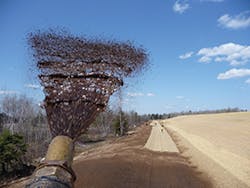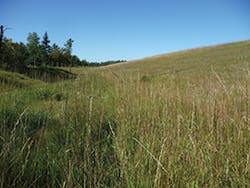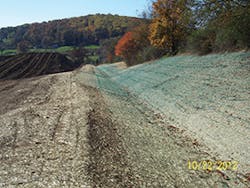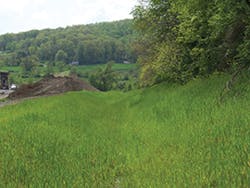Just south of Hattiesburg, MS, lies a power plant owned by the South Mississippi EPA (Electric Power Association). The power plant contains a cooling facility, in which water is circulated through the plant in order to reduce the heat from the plant’s operations.
Adjacent to the cooling plant is Black Creek, the state’s only designated National Wild and Scenic River. But sometimes the waterway gets a little too wild.
“When we would get large rain events and the creek came out of its banks, it would flow against the levee of the cooling facility. It was washing away the cooling facility levee,” explains Damian McKay, owner of Greenway, an erosion control company based in Wiggins, MS. “The fear was that it would eventually erode away the entire levee, and they would lose all their cooling capacity.”
With a little over a mile of levee involved, McKay was asked to come in and put a stop to the erosion.
“We put in the Profile Products GreenArmor system, which involves taking their Enkamat turf reinforcement mat and infilling it with Flexterra flexible growth medium,” he says. “Shortly after that installation, we got something like a 4- or 5-inch rain in a few hours’ time. The creek came out of the banks and washed all down the side of it, yet we didn’t have one single rill or eroded area along the whole bank. It performed exactly as it was supposed to. On the rest of the levee, we had Flexterra alone, which we sprayed on. It came out looking fabulous.
“We did not have one callback on the project, which the power company loved,” he continues. “South Mississippi EPA is very proactive with erosion control, and they realized that they were going to spend a little more money upfront, but in the end, they were going to save money because of the fact that this product was applied, and they would not have to come back with heavy equipment, they wouldn’t have to track it in, they wouldn’t have to redo all the dirt work or redo the seeding.”
Of the application process itself, he notes “Once you fill that mat up with the Flexterra, it’s virtually impossible to wash it out of there. I’ve had jobs where we’ve installed it, and there might have been a design engineering error in where a slope was placed, so we’ve had to tear it all out. When you pull it up, you’re pulling up mat, you’re pulling up dirt, you’re pulling up mulch. It’s all together; the roots are in there, the growth medium is inside the mat, and it’s just one big, continuous material.”
After one year of growth
He notes that the system is frequently used instead of rock or concrete riprap. “Riprap is called “˜hard armor’ because it is rock. Hence the name GreenArmor; it’s a “˜green’ product. It’s environmentally sensitive and it works. I was a little bit of a skeptic at first, but once I installed it on a few jobs, I became a believer.”
McKay explains the importance of getting good seed-to-soil contact. “You want that mat as intimately connected to the soil as possible. You staple it down so that there is no tenting and no air pockets under it. You want to get it as close to the soil as you can. Once the surface is smooth, then you trench it at top and trench it at the bottom. You roll your mat out, staple it down, and then you have to hose it. You cannot shoot it with a gun. If you shoot it with a gun from a truck, it floats out there and just settles on the mat. What you need is pressure, so you shoot from that hose straight down and fill that mat up. You’re making a blanket.
“It fills the mat up and it dries, and it is immediate. I’ve had jobs where we were spraying it in a driving rain, and it doesn’t wash away. It’s that good.
“When we apply GreenArmor, we apply all the additives that go with it. We’ll come in and test the soil, so we know what the nitrogen, potassium and phosphorus levels are, together with the other elements of the soil. Then we may add lime, or a product called Jump Start, which helps with germination rate. We may use BioPrime, which is a slow-release fertilizer that has a lot of micronutrients in it. We add it all in there with the GreenArmor, to specifically meet the needs of the soil.
“Often, hydroseeding or hydromulching companies will go out and spread seed and fertilizer, and think it’ll grow, but it’s all about what the soil has. If the soil is sour, you’re not going to grow grass. It doesn’t matter what kind of hydromulch you put down or how much water you put on it. You have to have your N, P, and K correct.”
Colorado Mine Reclamation
Northwest Colorado is home to a large number of coalmines. One of them, near Steamboat Springs, has been undergoing reclamation efforts for about 20 years.
“They get quite a bit of snow up there, so every spring they get a lot of runoff,” notes Todd Croke, of Nilex USA, based in Centennial, CO. “The mine had closed down many years ago, but it’s been under reclamation.
“Some of the steep hills in the area cause significant scouring of natural drainage channels that go through there. A lot of the mining guys I talk to very often say that this area should never have been mined to begin with, because it’s so hilly. It’s a very unusual kind of area to do a strip mine, because you do get so much runoff and so much erosion there.
“Initially, like a lot of people, they used rock riprap to try to control erosion of drainage channels, because it’s been used for so many years. But riprap is so rough that it ends up tumbling down the slopes. It then needs to be hauled back up every year.
“With large projects like this, they often anticipate things that are going to fail. They understand that they do the best they can to control the unusually severe conditions that they have. They eventually were resigned to the fact that the riprap fails every year and that they had to just haul it back up and do the best they can and move on.”
However, several years ago, Croke suggested replacing the riprap with Tensar North American Green’s turf reinforcement mats (TRMs). He was confident that the problems associated with riprap would be significantly reduced.
“They tried it out, they liked it, and they continue to use it to this day,” he reports. “The smoothness of the TRMs allows the water to go through with a lot less turbulence, and they don’t get as many failures. They still get some, just because of the severe situations up there, but by and large, it’s been very successful.”
The specific turf reinforcement mat used is Tensar North American Green P550. Croke explains why this TRM was selected over alternative options.
“At the time, it was one of the strongest materials they had, and they needed that high-tensile strength in order to prevent damage to the matting before it becomes vegetated. Once vegetation grows up through it, it will hold the matting down on the ground very well. But before that, you’re really relying on the anchoring system, and how it’s being stapled down to the ground, and also how strong the netting is in the TRM.
“That’s the first reason they chose the P550 TRM system. The second is that this is in the middle of the mine, so they don’t get great vegetation established right away. It takes a very long time, and the P550 has a permanent matrix, a permanent polypropylene mulch. A polypropylene mulch provides a long-term cover for the soil while vegetation is established.
“When you compare this to products such as the Tensar North American Green VMax C350 that has a coconut matrix, that’s more appropriate for areas where you’re going to have vegetation established within a couple years, maybe three years, but for longer than that, you want to go with a more permanent type of mulch.”
Croke notes that although there wasn’t much in the way of good soil in the midst of the coal mining area, nevertheless some substrate is required.
“There’s a common misconception with these permanent systems that they can be used permanently by themselves, forever. But you have to have something for it to attach to. With any TRM (hence the name-it’s a turf reinforcement mat), it needs to have vegetation in order to control erosion permanently.
“It will work by itself for a period of time before vegetation becomes established, but after that time, you need to have something growing through it. Now, it doesn’t need to have 100% density. It can work with less. Testing has shown that with as little as 30 to 40% density of vegetation, we still had significant increases in the ability of the matting-vegetation system to control erosion.”
According to Croke, the Colorado Department of Transportation requires that only biodegradable nets be used with erosion control blankets in most cases, but turf reinforcement mats are a different product. “By definition, TRMs are never going to be degradable. Erosion control blankets are degradable, while TRMs are permanent.”
“Because of the mining here, the landscape has been changed. Although the people who own the mine do an outstanding job of restoring the land back to pre-disturbance levels, there is always going to be a little bit of difference, and it’s understood that there are going to be some permanent structures left over after mining activities take place. So they don’t require that all erosion control materials be made biodegradable. There are some mines in the area that do require that, but this one does not.”
He notes that seeding takes place before the TRMs are installed. “That’s the case with almost all erosion control blankets, and probably most of the TRMs. There are two types of TRMs on the market today. There is a surface-applied material, like the P550 system, which means you seed, fertilize, and do whatever you’re going to do to the soil first, and then you align the TRM over the top. You want that to be the uppermost layer, in order to control erosion. With this system, usually you’re not going to hydromulch the ground, because this TRM contains mulch already. In this case, they drill seeded it. We have a very dry climate most of the time, and drill seeding just seems to work the best. Most of the people here use that whenever they can.
“Then there are soil-infilled TRMs that you lay down onto the ground and then fill them with soil, and then seed over the top of that. You would usually put a hydromulch or erosion control blanket over the top of the TRM. That’s not something that we promote here, because we feel that it is extra work and that erosion control is better accomplished with a one-step application.”
On this project, other BMPs were used, including some silt fence. “But they eventually transitioned over to straw wattles and wood fiber wattles,” Croke says. “Excelsior fiber wattles are what’s mainly being used up there now, because silt fence almost always gets blown down. It’s just a constant maintenance concern. They always have to go out and fix it and replace parts of it. Instead, the lower-profile item, such as an excelsior wattle, will still accomplish the same thing in limiting sediment from running off, but it doesn’t blow over like a silt fence does.”
In addition, some riprap remains at the site, particularly at the bottom of some of the channels. “They’ll use that to dissipate the energy in the channels themselves. If you’re putting riprap on a 1:1 slope, the tendency for it to roll downhill is pretty great, especially when it’s being pushed by water.”
Significant rain or snow events challenge the TRMs every year. Croke explains that while the bulk of the TRMs remain intact, inevitably there will be some failures, especially in areas where the speed and turbulence of passing water increases. These forces exceed what can normally be withstood even by these high-tensile-strength products. When this occurs, the area in question needs to be regraded and reseeded, and new TRMs need to be installed.
Croke notes that the mine owners have been very pleased with the results. “They’re really supportive. They order materials from us every year. They’ve even talked about it at various conferences, describing what they’ve done with the TRMs. They’ve made it pretty public that they’re supportive of using TRMs in these mining situations.”
One more reason TRMs have proved advantageous for this project is the simple fact that the area is so remote.
“You’re in the middle of a landscape that’s difficult to get to,” says Croke. “They have to reclaim the roads that they used to use for mining. So hauling many square yards of rock riprap back to these areas is a lot more difficult than hauling TRMs. TRMs are a lot lighter, easier to work with, and you don’t need as much heavy equipment.”
Because of the remote location, the TRMs are not watered at all by the mine owners or their contractors. According to Croke, “One way they get around that is that these reclamation managers have very specific grass seed mixes that are used. We don’t supply those, but they are very specific mixes that will work well in a given area.
“Before reclamation, they go out and take aerial photos of where aspen grows, what type of grasses were there, and they collect seeds. It’s very meticulous, before mining even starts. So they can make sure that they can replace trees and grasses and with the exact type of species that was there before they started mining. They take these aerial photos every few years to see how things are progressing and compare that to what it was pre-disturbance.”
A diversion swale lined with ECP-2 turf reinforcement mats
Growing on Pure Sand
The Canadian federal government, in conjunction with the province of Manitoba, decided to expand several of its correctional facilities. Keith Porter, owner of Mid-Canada Hydroseeding, describes what occurred at the Milner Ridge facility recently.
“It was a phased project intended to triple the size of the existing facility. The earthmover came in and created a lagoon. There was really no thought about revegetation or erosion and sediment control at the time. They built the lagoon and put the liners down and top-dressed everything with several feet of the parent soil, which in that neck of the woods was pure sand.
“They created 4:1 slopes that were around 100 feet in length, from the top of the lagoon down to the existing land around it. When the first rain event came, they got a foot or two of rilling right down to the liner, exposing the liner on the slopes. So they brought the general contractor back in to regrade the whole area and get it shaped up. They figured this was just a fluke event.”
However, Porter says, the next time it rained the same type of rilling occurred. “So a call went out to Mark Myrowich of Erosion Control Blanket and to me, asking what could be done about this situation. They had toyed around with the idea of importing topsoil on and blowing straw mulch over it. But we told them about the Verdyol Biotic Earth product from Erosion Control Blanket, and explained that this would be a better product for less money.
The same swale after revegetation
“Being a government, however, they wanted to send the topsoil and straw idea out to tender, to see what kind of numbers they got. I think a bid came in around $650,000 to do that project. There’s no topsoil here, so it would involve two or three hours to haul topsoil in.
“We told them we could do the Biotic Earth material, and we don’t have to haul it in. We just ship it in by truck in bags, and spray it on with a hydroseeding machine, and put an erosion control blanket down over the top of it.”
The government opted for this alternative, which would cost about half of the estimated amount for topsoil and straw, but wanted to know if the work would be guaranteed. “I said if they allow me to keep an eye on it, and if they don’t mow it, just leave it alone, let me fertilize it and work with it, then we can do something like a two-year maintenance project, price it accordingly and turn it over to them and offer a guarantee.
“In typical general contractor fashion, we got called in at the end of the fall a couple years back and told to start. It was going to snow any day, but they wanted us to begin anyway. We got half of the installation done before the snows came. It was something like two feet of snow; it just shut us down. So we had to wait and come back in the spring. We figured if we could get in early enough, there would be very little erosion and we could continue on. And that’s exactly what happened. There was very little erosion, which we tuned up with a little Bobcat. We got the installation done, and then it started raining.
“In Manitoba here, you get a window between mid-April and the second week of May where it’s really nice, sunny weather,” he explains, “and then it usually starts raining for about a month. So it started raining, and we had the blankets down. It was fine, with nice light spring rains, good for growing grass. The sun would come out, and we saw a nice green haze coming up through the mat everywhere.
“Then the sky opened up, and the rains came down with a vengeance, something like 4 inches in three hours. We had specified in our warranty that anything over two inches is an act of God and can’t be controlled.
“The phone was ringing at seven o’clock at night; I was talking to the engineer and to people at the facility, and everyone was expecting that it was going to be a disaster. I was prepared for the worst, and told them that I can’t be held accountable, that money will have to be found to fix it.
“We all met out there the next morning and it was unbelievable. There was zero erosion. Nobody could believe it. Then the system just kept growing and growing and growing. The only place we’ve ever had any erosion is in an area that had nothing to do with the work we had done. The sewage lagoon has outlets at various cells, and there’s riprap that was put on the sand with geocloth under it. When they drained that, it actually undermined it and eroded. The funny thing was that it was the one thing that shouldn’t have eroded.”
He notes that everyone was surprised by how well the site held up even during the rains. “I thought that maybe I’m going to have to bring a little topsoil in eventually, but we never had to worry about that. We just added a little fertilizer to keep it nice and green.”
The project manager was equally impressed. “Our expectations with the finished product have been far exceeded,” he says. “Vegetation growth was rapid and consistent across the entire area.”
“We grew this on pure sand,” stresses Porter. “The only organic material was the Biotic Earth spray we put on. We usually use the year-and-a-half photodegradable mat. At Milner Ridge now, there’s nothing left. It’s building its own soil, so there’s vegetation. Just from thatch breakdown and leaves blowing down and rotting away, we’ve got about a quarter-inch of topsoil already, in four years.”
Swales and Detention Basins in Berks County
In an effort to bring jobs to its area, Berks County, PA, spearheaded a big-box store development located about two hours outside of New York City.
“It was on raw farmland,” explains Rick Geissler of Geissler Tree Farms. “There were some wetlands there before. We actually did some mediation work there at the beginning. We did some wetland seeding with conservation mixes a couple years ago. More recently, we did erosion control work and some slope stabilization on some of the road shoulders. We were involved with swales and other BMPs.
“We used a variety of products; there was the East Coast Erosion Blankets’ ECS, some straw-coconut biodegradable product, and their poly blanket on some of the steeper grades and slopes. We’re doing a lot of slopes with ECS-1, their single-mesh straw blanket.”
He says the site owner wanted to line some detention basins, which he had not done before. “They wanted to do the bottoms, because there is a 20-acre building that has its roof drains emptying into a two-acre pond, so it gets an unbelievable amount of water with every rain event. We worked on the detention basins, the slopes leading from the parking lot down to the detention basins, and swales that encompass the whole property to catch the runoff before it ever gets to the paved, impervious areas. We put the East Coast ECP-2 turf reinforcement mat, designed for high-flow areas, on some swales, and they have held up beautifully. You can’t even see any TRM any more. It’s totally vegetated.
“We just recently did a 2:1 slope with a biodegradable straw-coconut blanket from East Coast, the ECSC-2B. That’s coming up real nice. We’ve had exceptional weather this year, with lots of rain, so it’s all working real well.
“We’ve also had some severe rain events, some three to four inch rains, and the blanket areas have held up beautifully.”
Geissler explains the general installation process: “An area is graded and raked, and we get a skid-loader to work the slope. We hand-rake behind that. Then it is seeded and fertilized, and the blanket is then inserted on top of that. For seeding, we’re using a fescue mix, and we’re putting on rye to get it established, until the fescues take over. Most of the slopes we’re working with are at least 2:1.”





